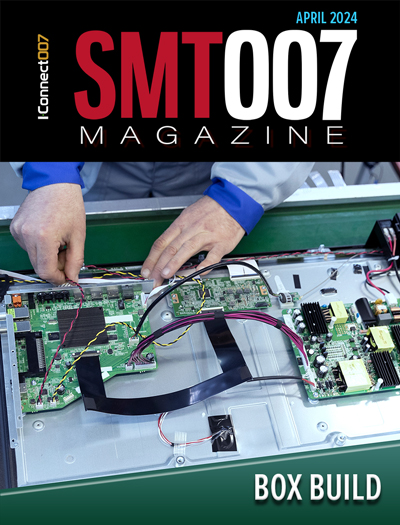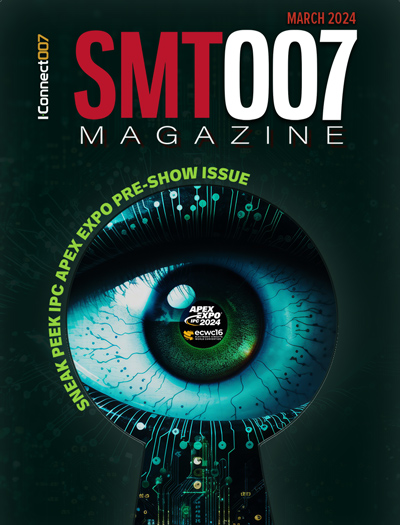-

- News
- Books
Featured Books
- smt007 Magazine
Latest Issues
Current Issue
Box Build
One trend is to add box build and final assembly to your product offering. In this issue, we explore the opportunities and risks of adding system assembly to your service portfolio.

IPC APEX EXPO 2024 Pre-show
This month’s issue devotes its pages to a comprehensive preview of the IPC APEX EXPO 2024 event. Whether your role is technical or business, if you're new-to-the-industry or seasoned veteran, you'll find value throughout this program.

Boost Your Sales
Every part of your business can be evaluated as a process, including your sales funnel. Optimizing your selling process requires a coordinated effort between marketing and sales. In this issue, industry experts in marketing and sales offer their best advice on how to boost your sales efforts.
- Articles
- Columns
Search Console
- Links
- Events
||| MENU - smt007 Magazine
Doug Pauls Explains Ion Chromatography
January 26, 2016 | Pete Starkey, I-Connect007Estimated reading time: 7 minutes
Residues from manufacturing operations may adversely impact the reliability of printed circuit assemblies in the field. But not all residues are harmful or detrimental: What is critical is to understand what kinds of residues are present and in what amounts. ROSE (Resistivity of Solvent Extract) techniques have been used as a measure of ionic contamination by bare board manufacturers and assemblers since the 1970s, and there is a huge installed base of ROSE test equipment. But does ROSE testing give sufficient information about the nature and origin of the residue in the context of present-day electronics manufacturing? Ion chromatography offers a more precise and selective analytical technique, but how does it work and how can it be used to determine electronic cleanliness? What ion-chromatography-based specifications exist and how they were derived, and how you would use this tool for process troubleshooting and optimization?
Principal Materials and Process Engineer at Rockwell Collins and Chair of the IPC Cleaning and Coating Committee, Doug Pauls drew upon his 25 years' experience in the use of ion chromatography for electronics assembly improvement to answer these questions, in a webinar presented on behalf of SMART Group and moderated by Bob Willis.
Pauls began by reviewing the status and limitations of ROSE testing, and discussed the reasons why the industry should not continue to use ROSE for acceptance testing against a background of almost everyone having the equipment for a test that was called up in the majority of purchasing specifications, that was easy to carry out, and easy to pass. But the methods and pass-fail criteria came from an era where high-solids rosin fluxes and CFC solvent cleaning were standard, and these were no longer relevant. Present-day assemblies were vastly different in component density, complexity, materials of construction, and manufacturing methods.
He drew attention to IPC-TR-583 ‘An In-Depth Look at Ionic Cleanliness Testing’, published as long ago as 1993 but still applicable, which had concluded that ROSE tests tended not to be repeatable or reproducible, the "equivalency factors" were not valid and that the equipment should not be used for product acceptance but only for the process control purposes for which it was originally intended. An example he gave from his own production facility was when a sudden increase in the result of routine ROSE testing gave early warning of a failure in the works DI water plant. But in general, his comment was: "You may know something is making the extract solution conductive, but you don’t know what. Many modern contaminants won’t even make an ionic cleanliness tester twitch! How comfortable are you using reliability criteria developed in the 1970s? You need a tool that is much more specific on the soils on your product. ROSE is a broad bladed axe – ion chromatography is a surgeon's scalpel!"
To explain how ion chromatography worked, he began with one of his renowned graphic analogies: this time vegetable beef soup, consisting of macaroni letters, beef, carrots, tomatoes, potatoes, broth, salt and spices, and a magical strainer with which he could separate all the individual constituents and examine them. In this way, he could determine the main differences between Doug Pauls’ soup and Bob Willis’ soup. But even if they contained the same proportions of macaroni letters, beef, carrots, tomatoes and potatoes, Bob's soup tasted different to Doug’s soup, and Doug’s primary magical strainer was unable to separate the components of the broth, so he needed an even finer magical strainer to resolve the salt, pepper, other spices and Bob’s secret ingredients. (Edible flowers, Willis later admitted…)
Back to the reality of ionic residues on printed circuit assembles: the extract solution was essentially a chemical soup of residues that needed to be separated out into individual species for identification and quantification, and this was achieved in the ion chromatograph by a specialised fractionating column and conductivity detector. Different columns and eluents were used for anions and cations, and the equipment worked at very high pressure although the pipework was of capillary diameter so actual flow-rates were very small, typically 0.25 ml/minute. Using his own system as the example, Pauls explained the function and contribution of each major component. "It might look complicated, but if you appreciate how a domestic plumbing system works, you will have no difficulty in understanding the basic principles." The sample, typically 10 microlitres, was introduced, either manually or with an autosampler, into a sample loop, and a multi-position valve admitted it to the separation column via a guard column designed to protect the separation column from any accidental gross contamination - it could cost $2000 to replace - where it was absorbed on the ion-exchange medium.
Page 1 of 2
Suggested Items
Real Time with... IPC APEX EXPO 2024: MYCRONIC's Evolution and New Solutions
04/17/2024 | Real Time with...IPC APEX EXPOHenry Crandall interviews Kevin Clue, the vice president of global sales for MYCRONIC's High Flex division. They discuss the company's evolution, emphasizing its strong customer relationships and its role as a versatile, turnkey solution provider. Kevin unveils new solutions launched at IPC APEX EXPO, including an AI-integrated inspection system and the A40 pick-and-place platform. The conversation also touches on the increased use of AI and deep learning.
Three Industry Leaders Receive IPC President’s Award
04/17/2024 | IPCIn recognition of their leadership and significant contributions of time and talent to IPC and the electronics industry, three IPC volunteers were presented with the IPC President’s Award at IPC APEX EXPO in Anaheim, Calif., on April 9, 2024.
Phil Kinner Pushes His Limits in Engineering and Running
04/17/2024 | Linda Stepanich, IPCEngineers break things on purpose. They like the challenge of putting things back together and making them stronger and more resilient. The skills engineers use to build products can also be used to rebuild their lives after a personal loss, something Phil Kinner learned when he laced up his running shoes after many years of a sedentary lifestyle.
Marcy's Musings: The Growing Industry
04/16/2024 | Marcy LaRont -- Column: Marcy's MusingsAfter decades of steady decline in the U.S. and Europe, the PCB industry is finally growing, especially in China Plus One countries. The U.S. for example, which seemed to have abdicated its title as the world leader in innovating high-technology cutting-edge manufacturing processes, is now in a race to regain what it lost and then some. The PCB fabrication industry is growing in the West, thanks to DoD funding, the CHIPS and Science Act, and hopefully, the passing of HR 3249, the Printed Circuit Board and Substrates Act.
Real Time with... IPC APEX EXPO 2024: A Strategic Market Realignment
04/16/2024 | Real Time with...IPC APEX EXPOMarcy LaRont hosts Thomas Kunz of Schmoll Maschinen GmbH and Kurt Palmer of newly formed Schmoll America to discuss the strategic changes and developments at Schmoll with their departure from Burkle North America in this Real Time with... IPC APEX EXPO 2024 video interview.


